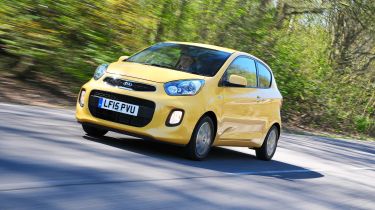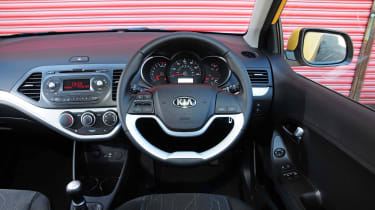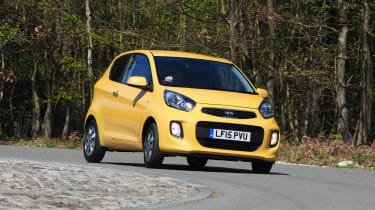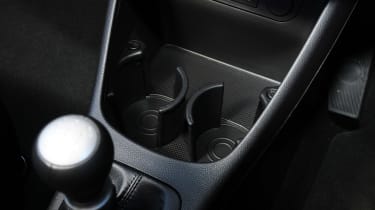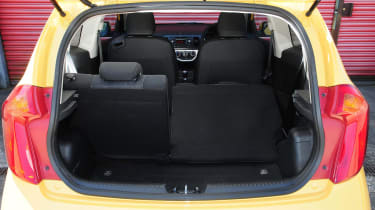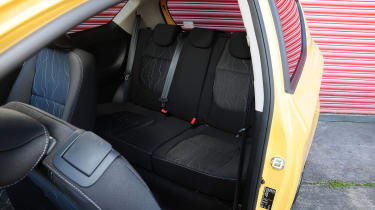Kia Picanto (2011-2017) review
Kia's smallest car is good looking and good value, but is showing its age with an outdated engine and interior tech

The Kia Picanto has been a successful city car for the Korean maker. But now that Kia is in the middle of revamping its range, with a new-generation Sportage SUV, the crossover-style Niro hybrid, plus a new Rio supermini, the second-generation Picanto is looking a bit old. It was facelifted in 2015 to compete with a raft of new city cars, from the quirky Renault Twingo to the value-for-money Vauxhall Viva and Suzuki Celerio. Even so, the Picanto is still one of the oldest cars in the class, as it first arrived in 2011.
Kia's latest model offensive has seen it launch a range of new, costlier SUVs as it bids to move upmarket, but the Picanto still flies the value flag as one of Britain’s cheapest new cars. The recently updated range now only comes with a practical five-door body - the three door model was never a big seller, even though Kia sold three-door exclusive trim levels.
The current Picanto range is being wound down ahead of the launch of an all-new Picanto in 2017, so now it just comprises of the Picanto 1, Picanto SE and Picanto Sport. The Picanto 1 and SE feature the 1.0 65hp three-cylinder petrol engine, while the Picanto Sport has the slightly livelier 1.25 84hp four cylinder petrol.
All models come with a five-speed manual gearbox, although you can upgrade the Picanto Sport to a four-speed auto, while the SE model can be had with the four-cylinder engine and an auto gearbox.
Used - available now

2020 KIA
Picanto
6,032 milesManualPetrol1.0L
Cash £10,999
2020 KIA
Picanto
22,693 milesManualPetrol1.2L
Cash £10,687
2020 KIA
Picanto
28,913 milesManualPetrol1.0L
Cash £10,229
2020 KIA
Picanto
32,016 milesManualPetrol1.0L
Cash £9,687Over the years, Kia has offered a number of special edition Picanto models, which have offered extra kit for added value for money. These are worth seeking out, as models such as the Picanto SR7, VR7 and Quantum are pretty well equipped by city car standards.
The Kia Picanto is feeling its age in places, but it’s still a stylish, solidly built supermini with lots of kit.
It also offers strong performance, yet the rest of the driving experience trails newer rivals. It’s less refined, less efficient and not as spacious, either, although the seven-year warranty boosts the ownership experience.
It has the choice of two small petrol engines, both of which offer fuel economy north of 60mpg providing you go for the manual gearbox on the 1.25. The smaller 1.0-litre unit has CO2 emissions from 99g/km, while the larger engine has from 100g/km, meaning some versions of both are currently free to tax.
• Best city cars on the market right now
The Picanto was facelifted in 2015 to bring it a little more up to date, and it includes plenty of standard equipment.
Engines, performance and drive
Light controls mean the Picanto is agile around town. Yet it isn’t much fun beyond the city limits, with inconsistent steering, an unsettled ride and sharp clutch letting it down. Road and wind noise intrude, too.
It’s quite comfortable, too. The suspension is soft, which means the Picanto handles bumps and potholes well. The trade-off is that this creates a bit of body roll that’s noticeable during corners.
Unfortunately the steering lets the Kia down out of town. It’s light enough to make the car simple to drive at low speeds, but it becomes unusually heavy when you speed up, so you end up with slow reactions to quick direction changes on A-roads and motorways.
The five-speed manual gearbox is easy to use and far superior to the four-speed automatic. You’ll pay more for the auto up front and it has worse fuel economy and emissions, leading to further costs down the line. It just isn’t worth it unless you have to have one.
Engines
There is a choice of two petrol engines: a 65bhp 1.0-litre three-cylinder unit and an 84bhp 1.25-litre. The smaller engine is available with 1 and SE models. It’s the more economical of the two engines but it’s also a bit sluggish. You’ll find it struggles on faster roads and becomes noisy as a result.
The larger engine is available on SE cars with the 1.25 auto and the Sport. The four-cylinder unit is a peppy performer and delivers strong pace. However, as it lacks low-end torque; you need to rev it to get the best out of it, and then it becomes noisy.
It’s still very capable around town but offers a bit more punch and is much better at coping with A-road motorway speeds – especially when it comes to overtaking. It isn’t much worse than the 1.0-litre when it comes to economy either, so it’s our choice of the two.
The 2015 facelift also introduced Kia’s ISG stop-start system to this engine, which improves economy further and gets emissions down to 100g/km.
MPG, CO2 and Running Costs
One of the main selling points of city cars is that they're cheap to run – and the Kia Picanto is no exception to this rule. The smaller of the two engines – the 68bhp 1.0-litre three-cylinder – offers 67.3mpg and emits just 99g/km CO2.
The larger 1.25-litre engine returns 60.1mpg and emits 109g/km CO2. It can also be had with a four-speed automatic gearbox, but this is best avoided unless you must have an auto, as it increases running costs to as much as 50.4mpg and 130g/km, which means a higher tax bill.
Insurance groups
Insurance starts at group two for the Picanto with the 1.0-litre petrol engine. They rise to group five for the 1.25-litre model and reach as high as six for the top-spec automatic models. Whichever model you choose, those numbers are very low, so insurance shouldn’t cost much.
It’s a similar story for rival city cars such as the Skoda Citigo and the Hyundai i10. They start in group one and remain below group five, which makes them marginally cheaper for insurance than the Kia, but it’s unlikely to make a huge difference, especially given the low cost of the car.
Depreciation
The Kia’s low initial cost and good value nature means it holds on to its used price fairly well. One thing to bear in mind is the fact that it’s very cheap to buy in the first place, so even cars that claim to have stronger residual value percentages will, in reality, lose more cash if they’re pricier than the Picanto in the first place.
Interior, design and technology
The first-generation Kia Picanto was bland to say the least, but the second generation livened things up. As with other Kia models launched in the past few years, it has a far more upmarket, sporty design.
The standout feature is Kia’s ‘tiger-nose’ grille surrounded by a pair of swept-back, oversized headlights. Even with the restyled bumpers of the 2015 facelift it looks a little dated compared with newer cars such as the Renault Twingo, though.
The interior is neatly designed but has changed even less than the exterior in the 2015 update. Kia claims there's a range of brighter fabrics, but our test car came with black and silver trim that looked almost identical to that of the 2011 car. It’s well laid out and easy on the eye, though.
Tinted windows and 15-inch alloy wheels give the Picanto more road presence in Sport spec, although there’s no sports suspension to help car deliver on promise of its looks.
Sat-nav, stereo and infotainment
Sat-nav is only available with the Sport model, itself paired with the 1.25-litre engine. It’s a seven-inch touchscreen system but unless you want that particular model there’s no other option for a Picanto with sat-nav, so it may be worth considering an aftermarket system.
Bluetooth, USB and aux ports come with SE trim levels and above, which covers most of the range save for the entry-level 1 model.
Practicality, comfort and boot space
The second-generation Picanto is more spacious on the inside than the previous model because it has a larger wheelbase (distance between the front and rear axles). Kia dropped the three-door model in early 2016, so there's just the single five-door body style on offer. Visibility is good and the Kia is very easy to manoeuvre.
There are plenty of storage compartments and cubbyholes dotted around the interior, plus a decent sized glovebox – mid-spec models get a twin cup holder underneath the centre console as well. Frustratingly, though, the steering wheel only adjusts for rake, not reach, so the driving position is rather inflexible.
Size
The Picanto is 3,595mm long, 1,595mm wide and 1,480mm tall, so it’s a compact little car. It’s a little shorter than the Hyundai i10, though it’s marginally longer than the Skoda Citigo, so the Kia is about average for a city car.
Leg room, head room & passenger space
City cars are obviously not the last word in rear passenger space but the Picanto does well for its size. The seats are comfortable and supportive and there’s enough room for two adults to sit in the back without any complaints. Again, access is better with the five-door but that’s to be expected.
Boot
The Picanto’s boot has 200 litres of space, which is pretty average for the class. It’s better than the Fiat 500 but some way behind newer rivals: the Volkswagen Group’s trio of city cars – the VW up!, the SEAT Mii and the Skoda Citigo – have 251 litres of capacity, while the class-leading Hyundai i10 has 252 litres of space.
The Kia comes with 60:40 split-folding rear seats as standard, though, which helps to improve practicality. Fold them flat and the amount of room in the boot increases to 605 litres. The boot has a wide opening too, which helps with squeezing in large objects.
Reliability and Safety
One of the areas in which the Picanto is starting to show its age is its safety rating, as it scored four stars in the Euro NCAP crash test. However, you shouldn’t let that rating put you off because the Picanto was marked down by Euro NCAP on the grounds that entry-level European models don’t come with electronic stability control as standard – but entry-level UK cars do.
The Picanto scored decent marks for adult occupant and child occupant protection, receiving 86 per cent for the former and 83 per cent for the latter. It also comes with a decent range of safety kit, including ABS, traction control, ISOFIX points for child seats and driver, passenger, side and curtain airbags.
There should be no reliability problems with the Picanto. The quality of Kia’s cars has really improved in recent years, and fit and finish is far superior to the slightly tacky models of old.
Kia has also been performing well for reliability in our Driver Power customer satisfaction surveys, although it dropped from a strong seventh place in 2014 to a merely average 19th in the manufacturer section of our 2015 survey.
The Picanto itself finished 125th out of 200 cars in the 2015 survey. That sounds quite poor but it actually performed very well for reliability, for which it was ranked ninth overall. Owners didn’t rate it well for performance, handling and ride quality, which were the biggest factors in its overall position in the lower half of the table.
Warranty
This is an area in which Kia is a market leader, as the firm offers a seven-year/100,000-mile warranty with its cars. No rival can touch it for length of time, but rival city cars such as the Hyundai i10 and the Toyota Aygo have five-year/unlimited mileage warranties, so that’s worth bearing in mind.
Servicing
Kia has a pair of fixed-price servicing packages known as Care-3 and Care-3 Plus that cover the cost of the first three or the first five services. The firm doesn’t advertise the exact price as it varies depending on the model but it does claim to be “extremely competitive”. The Care-3 package also reduces the price of the car’s first MoT to £30 and there’s a monthly payment plan available.

